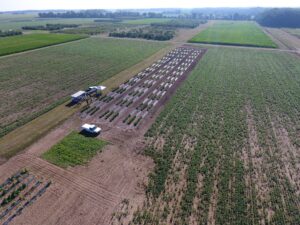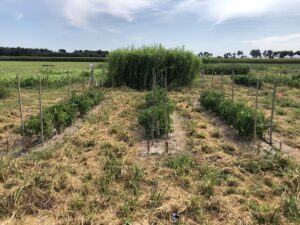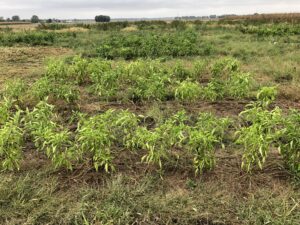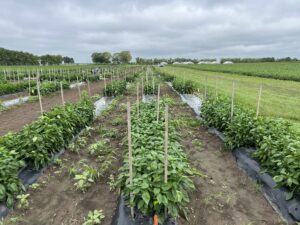Apr 3, 2023Mix organic, conventional methods to boost soil health
It is often presumed that organic agricultural management practices cause minimal environmental impact relative to conventional agricultural management practices.
Just like any other farming system, organic farming systems have limitations. Over-applicating organic amendments, such as composted manure as the sole source of fertilizer input, can result in high nitrate concentrations leaching into groundwater, compared to conventional systems using more accurate fertilization methods to distribute fertilizers when the plant needs it and in the correct amount.

Compost applications can also contribute to excessive soil phosphorus in organically managed production systems if added at rates greater than phosphorus removal in the harvested crop.
The over-application of fertilizer on conventional farms also leads to the leaching of nutrients into the environment. This can result from over-applicating irrigation water or heavy downpours during thunderstorms.
It doesn’t matter what farming system you use. Soil fertility cannot be managed in isolation. Microbial activity and the mineralization of nutrients are inseparable.
Building soil health requires much biomass, and cover cropping provides a sustainable solution for farmers. The biomass produced adds organic material to the soil, increasing soil carbon, reducing soil erosion, enhancing nitrogen cycling within the plant-soil system by reducing nitrate losses, increasing water retention, and reducing weeds in subsequent cash crops. Adding organic matter improves the physical condition of the soil and increases the population of soil microbes and earthworms.
Talking to vegetable growers in Indiana, we determined that they see the benefit of healthy soils on the farm. They realize that healthy soil can potentially increase yields and crop drought tolerance and reduce farming inputs in the long term. We asked ourselves: How can we assist vegetable farmers in adopting more sustainable farming practices?

Growers have concerns: How long does converting to a new or more sustainable farming system take? Will I be able to maintain productivity, profitability and quality? How much would it cost to convert, and what are the short- and long-term benefits?
At the onset of the pandemic in March 2020, we considered solutions to address farmers’ questions and concerns. Will a mixed system or integrated approach be more suitable for intensive vegetable production systems? We hypothesized that an integrated cropping system and fertility management program would yield better soil health and production results for growers that do not intend to certify organic but want to be more sustainable.
We wanted to know if increasing soil health scores reduces input requirements over time. Also, are soil health scores predictors of pepper variety performance and fruit quality? Currently, soil health testing is based on the Haney H3A soil test. This test was primarily developed for row crop production systems. The test quantifies the amount of nutrients available to crops and accessible to microbes. It evaluates soil health indicators such as soil respiration, water-extractable nitrogen and carbon and their ratio, among others. The test is not perfect. It does not take water infiltration and soil compaction into consideration. Ultimately, we agreed that the test provided a uniquely comprehensive look at nutrient needs and soil health.

We initiated research in 2021 at three locations in Indiana: north (Wanatah), central (Lafayette) and the south (Vincennes). (Fig. 1) Climatic conditions and soil type differ at these locations. Treatments included organic or conventional fertilizer sources, manure or plant-based compost sources, summer cover crops (sorghum, Sudan grass and sunn hemp) in year 1, and a mix of cereal rye and hairy vetch cover crops in the fall/winter.
Some treatments received no additional biomass during the experiment, except for pepper crop residue, some received a lot with the summer cover crop in year 1, and some continue to receive more with the fall/winter cover crop. Soil tests are conducted in the spring and fall, and we used crop removal estimates to determine application rates.
We aimed to manage fertility with similar soil nutrient levels in each treatment. That requires using both conventional and organic fertilizer sources in compost and cover crop treatments. We experienced several issues in 2021. We did not use plastic mulch on the raised beds or any herbicides. We soon ran into weed issues (Fig 2). Grass took over the research plots, and we could not keep up with weeding. The weeds scavenged nutrients intended for the crop, and we lost nutrients due to runoff and leaching (Figs. 2 & 3).

In 2022, we had to amend the production protocol. Plastic mulch was used on the raised beds, and we applied a pre-emergent grass herbicide two weeks before transplanting. This resulted in much better weed control, reduced fertility losses and increased yields (Fig. 4).
Between the spring of 2021 and the fall of 2022, we increased the soil health score by more than 100% in most treatments at our Lafayette research location. In most treatments, we have seen increases in soil respiration (Solvita CO2-C burst test), water-extractable organic carbon, total available P2O5, and K2O. Pepper yields were higher in treatments with higher soil health scores. We have completed two years of the four-year study. The trends mentioned are preliminary, but we are excited about future results. More information about the project can be found here: https://ag.purdue.edu/department/agecon/extension/soiltomarket.html.
This research is part of a USDA AFRI project, Taking the next step as a small and medium-sized farm: Understanding the integration of production, food safety, and profitability, award # 2021-68006-33893.
— Petrus Langenhoven and Nathan Shoaf, Purdue University
Fig. 1: An aerial view of a research plot at Lafeyette, Indiana. (Throckmorton/Meigs Purdue Agricultural Center) Photo: Ashley Adair.
Fig. 2: In 2021, weeds were flail-mowed between rows and pulled by hand in the planting row. Photo: Petrus Langenhoven
Fig. 3: Plant-based compost treatment (front) and a mixed organic and conventional fertilizer treatment (back) in 2021. Photo: Petrus Langenhoven
Fig. 4: Improvement in weed control and fertility management in 2022. Photo: Petrus Langenhoven
















